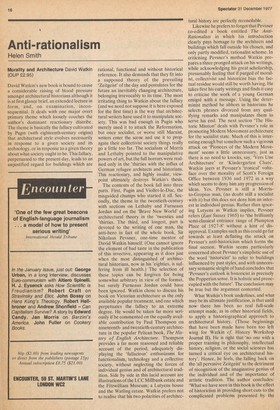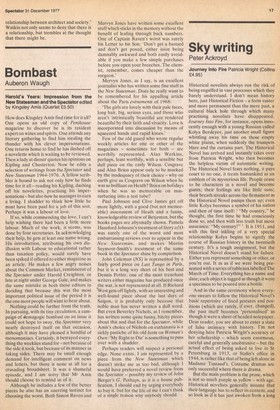Anti-rationalism
Helen Smith
Morality and Architecture David Watkin (OUP e2.95) David Watkin's new book is bound to cause a considerable raising of blood pressure amongst architectural historians although it is at first glance brief, an extended lecture in form, and, on examination, inconsequential. It deals with one major overt primary theme which loosely couches the author's dominant reactionary diatribe. The theme is basically the fallacy cultivated by Pugin (with eighteenth-century origins) that architectural style evolves necessarily in response to a given society and its technology, or in response to a given theory about what society ought to be. This fallacy, perpetuated to the present day, leads to an unjustified regard for buildings which are
rational, functional and without historical reference. It also demands that they fit into a supposed theory of the prevailing 'Zeitgeist' of the day and postulates for the future an inevitably changing architecture, belonging irrevocably to its time. The most irritating thing to Watkin about the fallacy (and we need not suppose it is here exposed for the first time) is the way that architectural writers have used it to manipulate society. This was bad enough in Pugin who merely used it to attack the Reformation, but once socialist, or worse still Marxist, writers enter the scene and use it to propagate their collectivist society things really go a little too far. The socialism of Morris and Lethaby pointed to the manipulative powers of art, but the full horrors were realised only in the 'thirties with the influx of German refugee architects and historians. This reactionary, and highly insular, viewpoint ultimately destroys Watkin's thesis.
The contents of the book fall into three parts. First, Pugin and Viollet-le-Duc, the misguided chumps who started it all. Secondly, the theme in the twentieth-century with sections on Lethaby and Furneaux Jordan and on the 'Brave New World' of architectural theory in the 'twenties and 'thirties. The third, and longest, part is devoted to the writing of one man, the anti-hero in fact of the whole book, Sir Nikolaus Pevsner, one-time mentor of David Watkin himself. (One cannot ignore the element of bad taste in the publication of this invective, appearing as it does just when the most distinguished of architectural historians, now in his 'eighties, is suffering from ill health.) The selection of these topics can be forgiven for being somewhat arbitrary in view of the format, but surely Furneaux Jordan could have been ignored. Watkin chose to discuss his book on Victorian architecture as the only available popular treatment, and one which perpetuates the fallacy to an extreme degree. He would be taken far more seriously if he commented on the equally available contribution by Paul Thompson on nineteenthand twentieth-century architecture in the popular Pelican book, The History of English Architecture. Thompson provides a far more reasoned and reliable account of the period, adequately displaying the 'fallacious enthusiasms for functionalism, technology and a collective society, without neglecting the forces of individual genius and of architectural tradition. Side by side in this lucid account are illustrations of the LCC Millbank estate and the Fitzwilliam Museum; a Lutyens house and the Watling estate. Watkin prefers not to realise that his two polarities of architec
tural history arc perfectly reconcilable.
Likewise he prefers to forget that Pevsner co-edited a book entitled The AntiRationalists in which his introduction clearly pays homage to the architects and buildings which fall outside his chosen, and only partly modified, rationalist scheme. In criticising Pevsner's method Watkin prepares a three pronged attack on his writings, while acknowledging his great scholarship, presumably feeling that if purged of moralist, collectivist and historicist bias the factual residue would still be worth having. He takes first his early writings and finds it easy to criticise the work of a young German emigre with a message. Using the determinist method he abhors in historians he selects phrases divorced from any qualifying remarks and manipulates them to serve his end. The next section 'The Historic Mission' deals with Pevsner's role in promoting Modern Movement architecture for the socialist state. Much of this is interesting enough but somehow such a vigorous attack on 'Pioneers of the Modern Movement' seems a little unnecessary, just as there is no need to knocks, say, ‘Vers Une Architecture' or 'Kindergarten Chats'. Watkin jeers at Pevsner's 'ironical' volteface over the morality of Scott's Foreign Office between 1936 and 1972 in a way which seems to deny him any progression of ideas. Yes, Pevsner is still a Morristo-Gropius man, (no doubt still a socialist with it) but this does not deny him an interest in individual genius. Rather than ignoring Lutyens as Watkin implies, Pevsner refers (East Sussex 1965) to 'the brilliantly semi-classical entrance range of Plumpton Place of 1927-8' without a hint of disapproval. Examples such as this could go far towards at least deflating the attack on Pevsner's anti-historicism which forms the final section. Watkin seems particularly concerned about Pevsner's simplistic use of the word 'historicist' to refer to buildings influenced by past styles, and with unnecessary semantic sleight of hand concludes that `Pevsner's outlook is historicist in precisely the Popperian sense. It is holistic and preoccupied with the future'. The conclusion may be true but the argument contorted.
What Watkin's book underlines, and what may be its ultimate justification, is that until now there has been no real full-scale attempt made, as in other historical fields, to apply a historiographical approach to architectural history. (Those beginnings that have been made have been too left wing for Watkin cf. History Workshop Journal II). He is right that 'no one with a proper training in philosophy, intellectual history, religion, or the social sciences has turned a critical eye on architectural history'. Hence, he feels, the falling back on the 'all pervasive Zeitgeist' to the detriment of recognition of the imaginative genius of the individual and of the importance of artistic tradition. The author concludes: 'What we have seen in this book is the effect of historicism in providing short cuts to the complicated problems presented by the relationship between architect and society.' Watkin not only seems to deny that there is a relationship, but trembles at the thought that there might be.







































 Previous page
Previous page